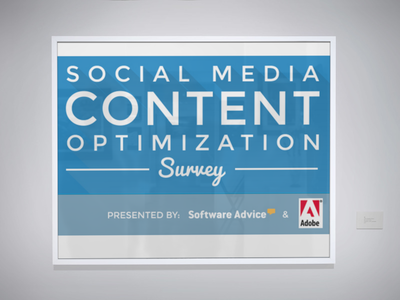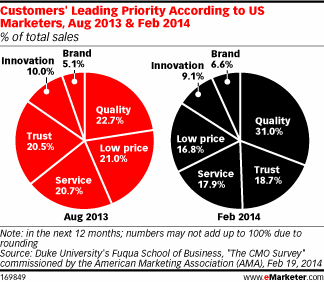When someone says, “Everyone else is doing it,” I generally turn and run. That’s just not a good reason for doing… anything.
But when it comes to social media marketing, “what everyone else is doing” can be good information. It can help you know what’s working and what’s not—so you can develop your strategy without having to learn the hard way.
That’s why I appreciated Software Advice, a social CRM research firm, sharing their early findings from the Social Media Content Optimization Survey, their first ever study on how marketers are optimizing social media content.
Source: Placeit.net
While I didn’t see any shocking revelations, the information in this survey is certainly worth reviewing. In particular, the top tactics for optimizing social media content.
Let’s review them now, then talk about what your goals should be for social media marketing, so you know how to get the best results.
Top Tactics for Optimizing Social Media Content
The survey uncovered 7 tactics for optimizing social content, but 3 stand out as being very important: using images or photos, using hashtags and usernames, and targeting specific groups and/or users.
Let’s zoom in and take a close look at the top three tactics. To learn more about the fourth, creating CTAs in social media, read this article.
Using photos and images
When it comes to content, there’s no better way to increase engagement than with pictures.
In blog posts, images have been found to increase engagement by 94%. That’s almost double the engagement an article gets with no images! And while I haven’t seen any numbers, I imagine you get a similar boost on social channels.
Both Facebook and Google+ were designed for sharing images. In fact, Facebook’s developers include high-quality images in their recommended best practices. Check out tip #4 below.
Even Twitter now includes in-stream images. Like this one, which I found in my stream recently.
Great words from @ponderful on the power of Twitter RT ($twtr #smwf #socialmedia) pic.twitter.com/noShYTAOJY
— Sean Gardner (@2morrowknight) April 6, 2014
Why are images important?
People are visual. Even if we have time to read—which most of us don’t—we understand new information better if it’s accompanied by an image.
In social media, people tend to scroll through their streams until something catches their eye. And let’s be honest, images are more likely to catch the eye than a text post.
So take time to find suitable images for your social content. Here are a few ideas:
- Eye-catching or creative photography
- Screenshots
- Entertaining images
5 stages of #twitter user #epic RT @Fifusince1992: hahaha epic #Obssesion xD pic.twitter.com/Os65KUlm4D“”
— Mia (@JointlyApart) April 5, 2014
Just one caveat with regard to images…
Be careful about using images of people. A study done by Taggs revealed that social content with images of people got fewer likes, shares and comments than posts with no people or with just a part of a person (hands, for instance).
Why? Taggs believes that “when Facebook user encounters a brand image of a product, lifestyle, or landscape without a person shown, the user is better able to project themselves into the image.”
In other words, they can connect better without other people in the image. And if they feel more connected, they’re more likely to like, share, or comment on the image.
Using hashtags and user names
A key to social content is getting it found. For that, there are no better tools than hashtags and user names.
Hashtags are familiar to most social media users. In Twitter and Google+, they tend to be keywords that ensure your posts are found by anyone searching for those terms. Here’s a good example from one of our Crazy Egg tweets:
Successful sales copy doesn’t always have to be direct or hyped to get results. https://t.co/C95r6LLUQY #copywriting #sales
— Crazy Egg (@CrazyEgg) April 7, 2014
This tweets will be easy to find for anyone searching for tweets related to copywriting or sales.
Hashtags also provide a way for users to communicate with one another in real time. Follow a particular hashtag and any posts tagged with that hashtag shows up in your stream.
In Facebook, however, hashtags are also used to add depth and commentary to ordinary posts. Like this one:
Or this one:
I doubt anyone is searching for “BabyFriendly,” “illtakeit” or “itfits.” These are more like asides from the person posting, adding their own commentary to their posts.
Hashtags are great for making sure searchers can find your content, but what about people who aren’t searching? What if you just want to make sure someone sees your post? For that, there’s user names.
In Facebook and Twitter, you do this with an “at” sign and the person’s user name. @KathrynAragon, for instance. In Google+, use the “plus” sign, like this: +Kathryn Aragon.
This creates a tag, which alerts the person that content is being shared with them directly. Here’s how one marketer did this in Facebook:
This marketer was kind enough to share an article I had written. He could have just posted the link and be done with it. But by tagging me in the post, he let me know it was being shared.
That’s a good strategy because it serves as an introduction of sorts, putting you on that person’s radar. (If I see another post from him, I’ll probably pay attention.)
If you’ve written a blog post that features someone, you can use this same technique to let them know about the content. Like this tweet, in which I tag @ChrisGoward so he knows I reviewed his book:
New Post – The One (and Only) Way to Improve Conversions: You Should Test That! Hat-tip to @chrisgoward https://t.co/Rrg2r12xPP
— Kathryn Aragon (@KathrynAragon) March 3, 2014
In most cases, when you do this, the person will share your post, which helps:
- extend your reach
- increase your likes, shares, retweets, plus-ones
- spark a conversation with the person you’re tagging
- and even get introduced to others in that person’s network
Targeting specific groups and users
One of the top reasons for using social media is to build your network. Fortunately, you can easily build your reach and influence with the two tactics we talked about above. But sometimes, you can boost your efforts for quicker results.
Keep in mind, this tactic needs to be used with care. Go overboard, and you could look like a stalker, which will do more harm than good.
When you want to build relationship with a particular brand or influencer, pay attention to their social media streams. By helping them achieve their goals, you become an ally of sorts, and they’re much more willing to talk with you if try to reach out.
For example, you might follow them on Facebook, Twitter and Google+. When they share an article you particularly like, retweet it to your followers. Like their Facebook posts and plus-one interesting posts on Google+. Leave comments on their posts and respond to tweets.
Don’t overdo this, but do engage with one or two of their posts every week or so. Be sure to use their username tag when you do, so they see your activity (as in the examples I showed you above).
Over time, you’ll catch their attention and be seen as a friend, if not a super-fan and/or a resource. They may begin to recognize your name and even engage with you in social channels. At that point, you might be able to direct message (DM) them and get a response—because you’re a real person who has given them support and encouragement.
Let me repeat: Do this with care. It’s a great way to build relationships with specific individuals and brands, but rely too heavily on it, and you come off as creepy, which, I’m sure, is not your goal.
Why Be Social? How to Set Your Goals
Social Advice’s survey also measured marketer’s goals for using social media.
According to these results, most marketers are using social media to nurture relationships and build brand recognition. That’s as it should be.
Social media should never be done for the purpose of direct sales. It’s a terrific marketing tool if you use it properly: to build relationship and brand loyalty among your followers.
Which brings me to the real focus of social media marketing.
According to a Duke University survey of online shoppers, when people buy online, only 16.8% of them are looking for a low price and only 6.6% care about the brand. What matters most are:
- Quality of the product being sold (31.0%)
- Service (17.9%)
- Trust (18.7%)
Each of these concerns—quality, service and trust—can be developed through social content that helps people know your brand better.
Remember, people buy from brands they know, like and trust.
In social channels, people can actually “talk” to brand. They can sense the personality of the people behind the brand, and feel more connected because they’re “like” them. Rather than building a brand of stuffed shirts and gray suits, you can build a brand that’s accessible and real.
That’s not just philosophy, either. Brands like Coca Cola and Ikea have set this as their goal, and you can see it in their social channels.
Here at Crazy Egg, we’ve got the same focus:
And from our experience, it works. Build relationships in social channels, and you build the Like Factor, which over the long haul, increases your sales and brand loyalty as well.
Here’s what I recommend
Based on the results of this survey, you need to set relationship, brand loyalty and brand recognition as your top goals.
Then take time to optimize your social media posts:
- Use high-quality images to increase engagement.
- Employ hashtags to get your content found.
- Use user names to engage specific people.
- Now and again, build relationship with influencers or brands.
By the way, if you aren’t following us on social media, you should!
















